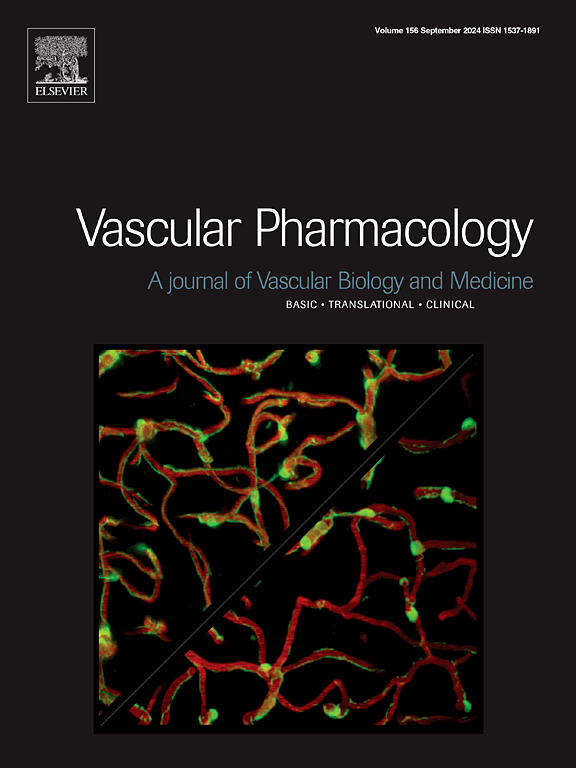Role of Xuefu Zhuyu decoction in improving pulmonary vascular remodeling by inhibiting endothelial-to-mesenchymal transition
IF 3.5
3区 医学
Q2 PHARMACOLOGY & PHARMACY
引用次数: 0
Abstract
Background
Pulmonary hypertension (PH) is a serious vascular disease characterized by pulmonary vascular remodeling. Xuefu Zhuyu decoction (XFZYD) can potentially improve pulmonary vascular remodeling; however, its mechanism requires further investigation.
Methods
Rat models of monocrotaline (MCT)-induced PH and chronic thromboembolic pulmonary hypertension (CTEPH) were employed to investigate whether XFZYD has the potential to improve pulmonary vascular remodeling. After 21 days of XFZYD administration, the right ventricular systolic pressure (RVSP), organ indices, and wall thickness of pulmonary arteries of the rats were measured. Considering the possibility of endothelial-to-mesenchymal transition (EndMT), the specific mechanism of XFZYD in improving pulmonary vascular remodeling was further explored. Immunofluorescence, immunohistochemistry, and western blotting were used to detect the expression of EndMT markers, transforming growth factor-β1 (TGF-β1)/Smad pathway-related proteins, hypoxia-inducible factor-1α (HIF-1α), and levels of reactive oxygen species (ROS) in the lung tissues.
Results
XFZYD demonstrated significant efficacy in treating PH, as evidenced by its effects in both the rat models of MCT-induced PH and CTEPH. XFZYD remarkably improved pulmonary vascular remodeling while reducing RVSP and right ventricular hypertrophy. XFZYD has the potential to improve pulmonary vascular remodeling by inhibiting EndMT in the pulmonary vasculature. The underlying mechanism may be closely associated with the inhibition of TGF-β1/Smad and HIF-1α signaling pathways and the reduction of ROS levels in lung tissue by XFZYD.
Conclusion
This study indicates that XFZYD may inhibit EndMT by modulating the ROS/HIF-1α/TGF-β1 signaling pathway, thereby improving pulmonary vascular remodeling. These findings provide a theoretical foundation for the clinical application of XFZYD in PH.

血府逐瘀汤通过抑制内皮向间质转化改善肺血管重构的作用。
背景:肺动脉高压(Pulmonary hypertension, pH)是一种以肺血管重构为特征的严重血管疾病。血府逐瘀汤对后者有潜在改善作用;但其作用机制有待进一步研究。方法:采用单芥碱(MCT)诱导的大鼠PH和慢性血栓栓塞性肺动脉高压(CTEPH)模型,观察XFZYD是否有改善肺血管重构的潜力。XFZYD给药21 d后,测定大鼠右心室收缩压(RVSP)、脏器指数、肺动脉壁厚度。考虑到内皮-间质转化(EndMT)的可能性,进一步探讨XFZYD改善肺血管重构的具体机制。采用免疫荧光、免疫组织化学、免疫印迹法检测肺组织中EndMT标志物、转化生长因子-β1 (TGF-β1)/Smad通路相关蛋白、缺氧诱导因子-1α (HIF-1α)表达及活性氧(ROS)水平。结果:XFZYD对mct诱导的大鼠PH和CTEPH模型均有明显的治疗作用。XFZYD显著改善肺血管重构,降低RVSP和右心室肥厚。XFZYD有可能通过抑制肺血管中的EndMT来改善肺血管重构。其潜在机制可能与XFZYD抑制TGF-β1/Smad和HIF-1α信号通路,降低肺组织ROS水平密切相关。结论:本研究提示XFZYD可能通过调节ROS/HIF-1α/TGF-β1信号通路抑制EndMT,从而改善肺血管重构。本研究结果为XFZYD在PH中的临床应用提供了理论基础。
本文章由计算机程序翻译,如有差异,请以英文原文为准。
求助全文
约1分钟内获得全文
求助全文
来源期刊

Vascular pharmacology
医学-药学
CiteScore
6.60
自引率
2.50%
发文量
153
审稿时长
31 days
期刊介绍:
Vascular Pharmacology publishes papers, which contains results of all aspects of biology and pharmacology of the vascular system.
Papers are encouraged in basic, translational and clinical aspects of Vascular Biology and Pharmacology, utilizing approaches ranging from molecular biology to integrative physiology. All papers are in English.
The Journal publishes review articles which include vascular aspects of thrombosis, inflammation, cell signalling, atherosclerosis, and lipid metabolism.
 求助内容:
求助内容: 应助结果提醒方式:
应助结果提醒方式:


